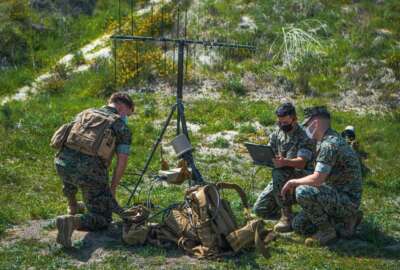DARPA is hard at work on the next generation of hypersonics
Hypersonic projectiles, missiles moving at five times the speed of sound, have become a high priority across the Defense Department. You've got two basic ways o...
Best listening experience is on Chrome, Firefox or Safari. Subscribe to Federal Drive’s daily audio interviews on Apple Podcasts or PodcastOne.
Hypersonic projectiles, missiles moving at five times the speed of sound, have become a high priority across the Defense Department. You’ve got two basic ways of getting projectiles to go that fast. One is the electromagnetic rail gun. The other is the use of what planners call air breathing engines, and those are the topic of a new effort at the Defense Advanced Research Projects Agency. Project manager Andrew Knoedler spoke with the Federal Drive with Tom Temin.
Interview transcript:
Andrew Knoedler: I think the new frontier is actually putting it in a small form factor than we’ve been able to I think in a long time. So you are correct way back in the sort of the late 40s and 50s did a lot of research in the area of ramjets, where we’re just compressing the air, adding fuel to it, and combusting, and expanding the air making that vehicle go. So I mean, if you’re really a history buff of aviation back, I think in the 60s, something was actually fielded called the Bomarc missile, which Boeing and Michigan I think it was Aeronautical Research Center put together. And what we’ve been trying to do ever since then, is create really a ramjet. And then a faster, what we would call a supersonic combustion ramjet, where the products of the fuel and the air, the oxygen in the air are combined at supersonic speeds. So that’s what we’ve been trying to do in our project here at DARPA, called the hypersonic air breathing weapon concept.
Tom Temin: So this would be then if you will, a miniaturization of what has been developed earlier so that it’s more practical?
Andrew Knoedler: It is more practical, at least from my perspective, and we’re able to look at a little bit faster speeds and those ramjets were going certainly greater than Mach 5. And then what we would like to do with those designs, of course, is create an engine that would ultimately be reusable. At this stage in our demo, we are looking at just something that’s one way so that we can put it in a missile form factor.
Tom Temin: And the use case then is an air launch, is that what you’re driving at?
Andrew Knoedler: That’s what we are doing right now in our demonstration. So we need to boost the sort of the front end of our vehicle up to speed where we can start the scramjet, which certainly means that we’re going pretty quick. So we use a rocket booster for that.
Tom Temin: OK, and so that’s the air breathing engine in other words, part of this?
Andrew Knoedler: Right, so the front end, the second stage is the air breathing part where we’re using the atmosphere, the oxygen in the atmosphere to combine with the fuel we bring on board as opposed to the booster, which is a solid rocket motor where you know, it carries the oxidizer and the fuel all together.
Tom Temin: OK, now I get it. And then let me just ask you this, the whole idea of the hypersonics, as we understand the current discussion in policy and weapons development is something that operates in the atmosphere because I mean, satellites have always been hypersonic, but they’re not down here where they’re useful as weapons. Fair way to put it?
Andrew Knoedler: That’s a fair way to put it. And what I can say is, yes, we’re in the atmosphere for these particular demonstrations that we’re doing with DARPA and the Air Force Research Lab.
Tom Temin: And while you’re developing the engine that pushes this thing, are you also working on the shape of the projectile? Because I imagine the ability to get as fast and far as you want, would depend on the shape of it.
Andrew Knoedler: Exactly. So when you mentioned before, hey, what is new about this? We’ve been able to use new advances in aerodynamics and computation to actually create a vehicle that doesn’t have much drag and allows us to use the scramjets, which are smaller than what may have been used in the past decades. So it’s very important for us to test so that we can go back and verify our computer modeling codes, that we’re doing it the right way and reducing the drag as much as we can.
Tom Temin: We’re speaking with Andrew Knoedler. He’s a program manager for the hypersonic air breathing weapons concept at DARPA. And you’ve mentioned the word scramjet a couple of times, just give us a brief explanation of scramjet versus ramjet.
Andrew Knoedler: Sure, so scramjet is part of an acronym, of course. So the S is supersonic, and the combustion is the C part. And then we just add ramjet there. So what happens say in really any type of engine, you’re compressing your oxidizer and your fuel together, you’re adding an ignition source, and then when you expand, or when that combination expands in some type of detonation or explosion, you’re going to convert that thermal energy to some type of power thrust or other type of work there. So when we look or if you would look at, say, an airliner engine, it compresses air in a certain way. It uses the jet engine blades in a mechanical way to compress that so if you go fast enough, you don’t have to have any moving parts. The air compresses naturally through a tube and then you can add the fuel and you get thrust out of the back. So once you go fast enough your air is going to maintain a supersonic speed, and then you have to mix things and light things and expand it all in a very short amount of time.
Tom Temin: So simple to say, but it’s a lot of very close engineering then, isn’t it?
Andrew Knoedler: It is in one of the things we really worry about is heat in all of this. So when we’re going that fast at the hypersonic speeds, we have to manage sort of the heat on all surfaces, whether it’s inside the engine, or outside on the vehicle itself.
Tom Temin: Yeah, so that was my question. What is your major technological or engineering challenge here? Is it the design of the engine? Is it heat management? Is it aerodynamics? Or is it how all the equations work together in a finished system?
Andrew Knoedler: I think there’s a little bit of each of those things that you said in our challenges. So certainly, we have used the information on the last sort of two big X plane successes in the hypersonic world, the X-43, and X-51. We’ve improved our manufacturing capabilities. In other words, we can figure out how to cool the vehicle the right way. And then we’re always getting better at verifying and validating the computer codes that we use to do the design.
Tom Temin: And what are your major metrics then for knowing this project could be something producible?
Andrew Knoedler: So when we started the program, we had certain goals, of course, to improve upon what had already been demonstrated at our previous X plane programs. So we wanted to go faster than Mach 5, we wanted to go farther than 300 nautical miles, and we wanted to go higher than 60,000 feet. So that’s what we were able to demonstrate in our most recent flight test demonstration just back in March.
Tom Temin: And how is this all getting accomplished? I mean, does DARPA have a fabrication facility? Do you contract it out? Because you got to make these things and then launch them and hope for the best who does all that machining and assembly and welding?
Andrew Knoedler: So DARPA is what’s called just call it a project management agency. So we come up with the ideas, and then we get the best and brightest within the industrial base, to provide us the actual design. And they go out and use their teams to test along with, say, the services aircraft in support. So our teams right now are Lockheed Martin and Raytheon each producing a different design.
Tom Temin: This isn’t one of those things where some entrepreneurial outfit somewhere that nobody ever heard of can get an OTA and do this?
Andrew Knoedler: Believe it or not, yes, they could. But have they done it with our program? No. When we set up the program several years back, that space wasn’t as robust as it is right now.
Tom Temin: All right. So you have demonstrated that you can go higher than 60,000 feet, 300 nautical miles at greater than Mach 5that’s actually occurred.
Andrew Knoedler: Yes, it has.
Tom Temin: Then what comes next?
Andrew Knoedler: Well, what comes next is, you know, that’s only one data point. So we are trying to conduct more flight tests, so that we can learn even more about the vehicles themselves. And then that technology will be transferred to the Air Force for a full weapons development program.
Tom Temin: Exciting stuff, then basically, isn’t it?
Andrew Knoedler: It’s certainly exciting for me and the teams that are working on this.
Copyright © 2024 Federal News Network. All rights reserved. This website is not intended for users located within the European Economic Area.
Tom Temin is host of the Federal Drive and has been providing insight on federal technology and management issues for more than 30 years.
Follow @tteminWFED







